If you have recently given birth and you’re past the worst of the aches, pains and sleepless nights, you might be considering jumping back into or starting a fitness journey.
During pregnancy, core muscles, including the abdominal and pelvic floor muscles, experience considerable stretching and weakening due to the expansion of the uterus and hormonal changes.
These significant changes often lead to conditions like diastasis recti, which involves the separation of abdominal muscles. In addition to causing aesthetic concerns for postpartum women, diastasis recti can also heighten the risk of back pain and pelvic floor dysfunction.
At POW8R, we understand how important it feels for women to regain control of their core and regain strength after pregnancy because we have experienced that feeling ourselves, but we also recognise that it is important to do it safely.
Keep reading to find out more about the best postpartum core exercises for new mums, some of which you can follow along with on the POW8R app under the guidance of expert trainers.
Why Core Recovery Matters Postpartum
Something that a lot of new mothers don’t know is that postpartum core exercises can play a crucial role in the recovery process for new mothers. When pregnant, your body goes through a lot, especially in your core.
Core recovery enables you to rebuild lost abdominal strength, enhance posture, and prevent common issues faced by new mothers, such as back pain and urinary incontinence.
After giving birth, it can be easy to feel unlike yourself, but doing the necessary exercise can help you start to feel like you again. At POW8R, we believe that working on your postpartum core is about more than just achieving a flat tummy after pregnancy; it’s about feeling strong, balanced and comfortable in your new body.
When to Start Core Exercises Post Pregnancy
Before you start any post-pregnancy stomach workout, you must first get the approval of your healthcare provider. Once you feel motivated to start working on your core, it can be easy to feel like you have to jump in straight away. However, remember that your body has gone through something incredibly intensive, so it deserves the necessary rest.
Keep in mind that these exercises aim to help you regain your strength, so take your time with them.
We recommend waiting until your 6-week postnatal checkup before starting any postpartum routine, particularly if you had a challenging labour, as this allows your body time to heal before beginning the rebuilding phase. However, you can start light pelvic floor exercises right after giving birth, so you can begin the rebuilding process while you wait.
In the meantime, develop a healthy, protein-focused postpartum diet plan, as this can help you fuel your body and make it easier to start your journey when you’re feeling ready.
Safe and Effective Core Exercises From POW8R
If you have been given the all clear by your doctor, you’re ready to start rebuilding your core, strengthening your muscles and achieving your goal physique. We recommend the following postpartum core exercises.
Pelvic Tilts
Pelvic tilts are a fantastic exercise for gently activating your deep core muscles after birth. During pregnancy, it is common to experience some lower back pain and discomfort, so pelvic tilts are a fantastic introduction to your routine to help alleviate some of this discomfort by improving your pelvic alignment.
Method
Lie on your back, either on the floor or a yoga mat, with your knees bent and your feet firmly planted on the ground. Tighten your abdominal muscles and try to hold your core, all while bending your pelvis towards the ceiling slightly, hold for ten seconds.
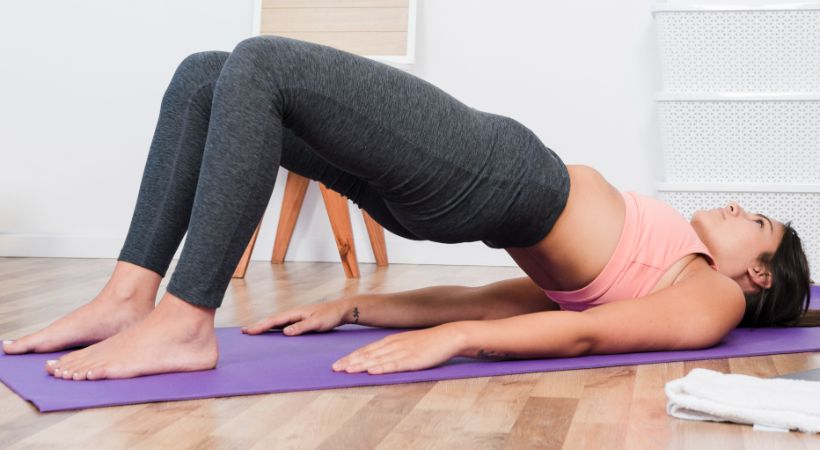
We will always suggest practising these exercises in sets of ten, but it is also important to listen to your body and do what feels comfortable for you as you heal.
Dead Bugs
Although this exercise may not have the best name, it is incredibly effective for strengthening your core. We suggest starting with a modified version of the exercise while you are recovering from childbirth. If you enjoy it and are seeing results, you can try a more progressive version of the exercise, with guidance available on the POW8R app.
Method
Lie on your back with your arms raised towards the ceiling and your knees bent at a 90-degree angle. If this position is uncomfortable, feel free to adjust as needed.
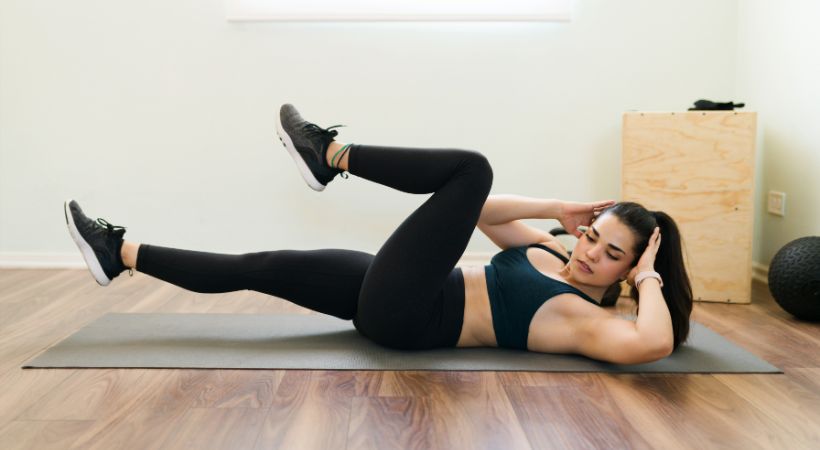
Slowly lower one arm and its opposite leg towards the floor, ensuring your core remains strong and you do not arch your back. Repeat on both sides for ten reps.
Glute Bridges
Glute bridges are absolutely fantastic for building your core strength after labour. Glute bridges strengthen the glutes, lower back and pelvic floor muscles, which are key target areas after birth.
Glute bridges can help you regain any lost core stability and also improve your posture, which childbirth can often distort. This simple yet effective exercise can have a significant impact on your postpartum recovery.
Method
To execute a glute bridge, start by lying on your back with your knees bent, feet flat on the floor, and arms resting at your sides.
Squeeze your glutes to elevate your hips off the ground, creating a straight line from your shoulders to your knees. Maintain this position for a second or two, and then lower your hips back down.
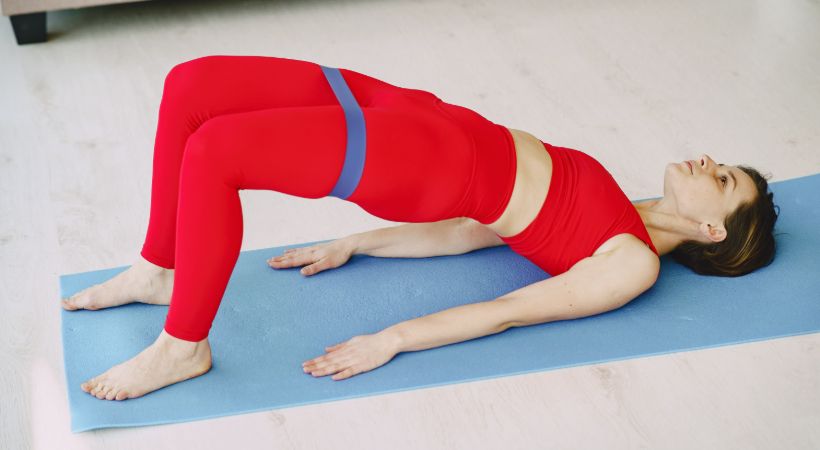
Once again, we recommend completing this exercise in sets of ten to experience the movement’s effect fully.
Heel Slides
Heel slides are a great way to activate your deep core without putting too much pressure on the abdomen. The best part about this exercise is that it can be completed while lying down, so if you want to incorporate some core movements but you’re still not feeling entirely recovered, this is a great starting point.
Method
Lie on your back with your knees bent and your feet planted on the floor. Gently pull your belly button towards your spine to activate your core muscle, hold as feels comfortable with your body.
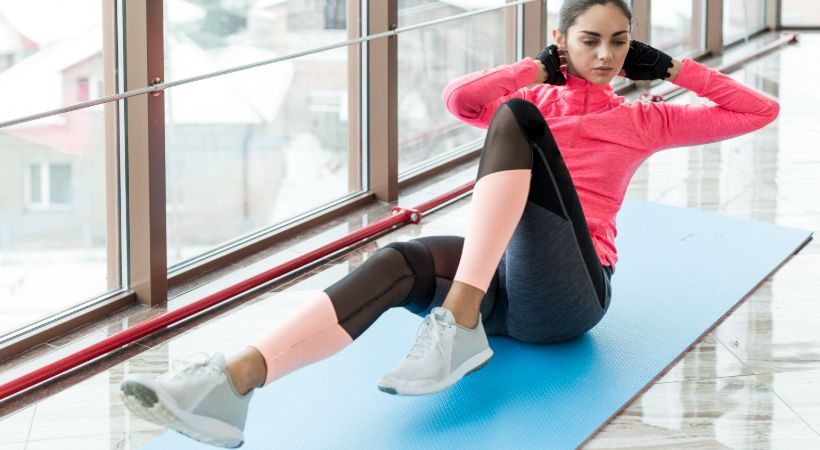
Once in position, slide one heel along the floor towards your buttocks, bending your knee as far as possible without arching your back. While maintaining core engagement, slide the heel back into the start position.
Repeat for ten repetitions.
Bird-Dog
When pregnant, something that can be affected is your posture and spinal alignment. This exercise is ideal for strengthening your core and enhancing your balance. Breathing and control are also a big part of this exercise, so mastering the bird-dog will help you with other parts of your workout journey.
While working to improve stability, this exercise may prove challenging for beginners, so please modify it to fit your needs and ability.
Method
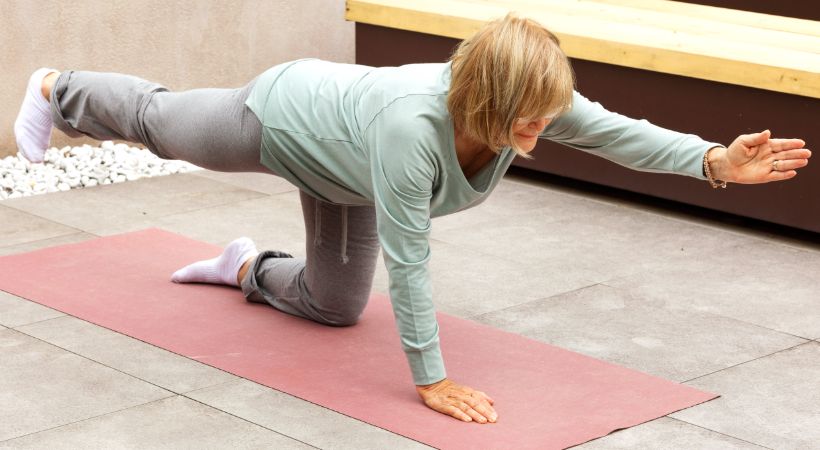
Position your hands beneath your shoulders and knees under your hips. Extend your right leg straight back while reaching your left arm forward, keeping it parallel to the ground. Sustain this position for two seconds, then switch to the other side. Repeat for ten reps or until failure.
Our Tips For Maintaining a Successful Postpartum Core Routine
If you have taken a significant break from exercise while pregnant, starting and maintaining a brand-new routine may prove difficult. Remember, developing a good core routine isn’t just about throwing yourself into an intensive routine and hoping for results; it’s about building sustainability.
Some ways that you can maintain a successful postpartum core routine include:
Consistency Instead of Intensity
The worst thing that you can do is throw yourself into a high-octane, heavy-weight workout routine that isn’t sustainable. Taking your time and developing a consistent routine is far more important than high-intensity workouts, as consistency delivers results more than the burnout that these workouts may cause.
Introducing a routine is primarily based on building habits that you can maintain. If you feel the need to skip a workout because it’s too high energy, that is not going to provide you with the consistency you need to see real results.
Focus on Form
A frequent challenge that many encounter is upholding a consistent routine while failing to see the expected results, often stemming from improper form. If the form isn’t executed correctly, you won’t effectively target your desired area or see visible changes and improvements.
If you are worried that you aren’t getting the form right, we recommend seeking guidance from a personal trainer, whether in person or online. A personal trainer can lay the foundations for a successful workout and ensure that you are getting the most out of your workouts from the outset.
A good coach will help you learn how to start exercising and working out in a way that meets your needs and ensures that you target your core correctly.
Introduce Pelvic Floor Exercises
Whether you deliver naturally or via cesarean, your pelvic floor is going to be affected by pregnancy. When pregnant, your pelvic floor muscles weaken, which can lead to future issues if not addressed quickly.
Starting pelvic floor exercises as soon as you can will help to stop incontinence, improve your sexual health and even reduce any pain that you are experiencing. When incorporating pelvic floor exercises into your routine, it’s essential to start early while maintaining your comfort throughout the process.
Avoid Heavy Workouts Without Medical Clearance
It is not unusual to be under the impression that to see the best results, you need to push yourself, lift heavy and test the boundaries, but this is not the approach you should take when practising core exercises post pregnancy.
After giving birth, you are exposed to a higher risk of injury and exacerbation of any existing conditions, so it is important to take things one step at a time. If you need extra guidance, we recommend that you check out our post-pregnancy fitness guide for more tips and always keep your midwife or doctor informed of your exercise habits.
Take Control of Your Core Strength With POW8R
Through this guide, we hope to have provided you with the relevant information necessary to help you build your core strength and recover after pregnancy.
Rebuilding your fitness and improving your core strength won’t just happen overnight. To get the best results, you need patience, guidance and a community of support backing you all the way.
Take a look at the POW8R app to see how easy starting and maintaining a postpartum exercise plan can be.